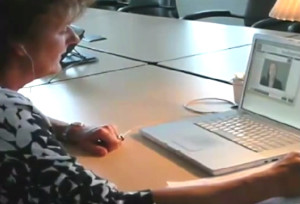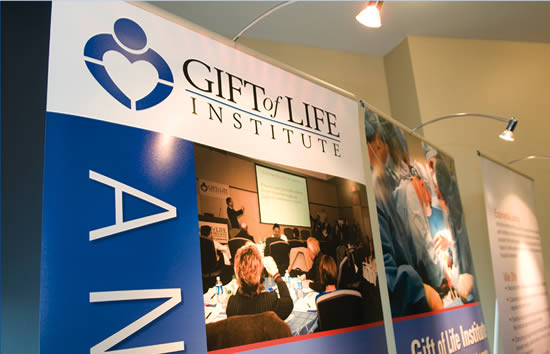As with most things related to relationship building, listening is key. When attempting to engage a physician, you’ll need to listen carefully to his or her language and learn to convey your donation information with that language in mind. In other words, speak the physician’s language.
Taking it to the next level, you’ll also need to discern the implications behind the physician’s language. What priorities does the physician’s language convey? It’s a fairly safe bet that those priorities include patient outcomes, family care, and process efficiencies.
It’s also important to consider any barriers to language that may result from your personal communication habits or OPO jargon. Specifically, what do you say and what does your hospital partner hear?
For example, you’ve probably used the term “early referral” when discussing donation. However, the physician could easily hear this as “too early.” Additionally, the physician could begin to use this terminology with colleagues who are less informed about donation. Instead, use the term “timely referral.”
Understand Their Perspective
It’s imperative when engaging physicians to put yourself in their shoes. Consider the following OPO terms and what they mean to us.
- Organ referral
- On-site; early linkage
- Optimize organ function
- Brain death pronouncement
- Collaborative request
- Compliance
Now, consider what each means to the physician. His or her perspective of terms may carry very different, and often sensitive, meanings.
OPO Term What it May Mean to Physician
| Organ referral | Failure and loss |
| On-site; early linkage | Family betrayal |
| Optimize organ function | Caring for a patient with no hope of recovery |
| Brain death pronouncement | Time, resources; futile care |
| Collaborative request | Loss of control |
| Compliance | Dictated practice |
Use your knowledge of the physician’s language and potential perspectives on donation terminology to understand where the physician is coming from. Then use the understanding of those perspectives to align goals or to be on the same page.
Remember, the most likely common ground that exists between you and the physician is the patient. Expand that probable common ground to include the patient’s family and efficiencies and you have a strong foundation for conversation. Donation best practice and policy implementation should center around the benefits of your partnership to this common ground.
Be Transparent
As an OPO professional, it’s your role to serve both the potential donor patient and the potential transplant recipient. This role as dual advocate is an undeniably important one and bears acknowledgement. Transparency in that role is necessary to achieve credibility as a partner and to ensure the best hospital development outcomes. From that foundation—and using language focused on common ground—it’s appropriate to discuss areas that may otherwise be sensitive ones for physicians.
One such area—critical to both maximizing and optimizing donation opportunities—is end-of-life clinical management. How a patient is managed clinically at end-of-life has profound implications on whether—and to what extent—donation is possible. While this area is exhaustive unto itself, it’s a great example of one that can benefit significantly from transparency in your role as dual advocate. The physician may perceive the OPO as “only out to get the organs.” He or she may feel you are asking physicians to perform inappropriate clinical interventions, draw resources away from other patients, or to go against the wishes of a patient or family.
Even though you may feel you are pushing very hard when meeting with a physician, it’s okay that you’re advocating for both potential donors and recipients. These people count on you to do so. But it is also okay that the physician has discomfort or differing opinions. His or her concerns are as real to the physician as your motivation for addressing the topic is to you. Neither should be disregarded.
Examine your use of language, try to speak the physician’s language, and acknowledge your different perspectives. Then use your common ground—usually the patient—to openly discuss your hospital development initiatives with transparency. In the end, this will often equate to full engagement of the physician as a partner.
Elizabeth Spencer has been working in the OPO community since 2002. She was with Washington Regional Transplant Community (WRTC) for nine years, serving as both Director of Hospital Services & Professional Education, and in the clinical division as a Senior Clinical Recovery Coordinator. As Director of Hospital Services & Professional Education, Elizabeth was responsible for oversight of partnerships with area hospitals regarding the implementation of donation best practices, donation educational programs for various hospital staff, hospital data analysis and reporting, hospital donation strategic planning, and hospital policies related to organ and tissue donation.
The field of organ and tissue donation is one of high stakes. In other industries, performance improvement might equate with more units manufactured and sold, more money made, or stock price increases. In ours, it means more human lives saved.
Providing effective feedback to OPO employees on job skills is a critical route to performance improvement. Giving feedback constructively can drive organizational performance in the grand scheme by affecting employee performance at the individual level.
Coaching
Employee skills coaching can take many forms. What is possible through coaching depends on many factors, such as the coach-trainee relationship. For instance, what is possible within an established manager-employee scenario may not be feasible within an online skills coaching scenario and vice versa.  In Gift of Life Institute’s WebEncounter training platform (an online application in which participants can role-play according to specific scenarios), the trainer has the advantage of a sometimes healthy separation that is unaffected by “office politics” or the reticence that can accompany mock role-play work and critique between established colleagues. However, this scenario is constrained by limitations in depth of knowledge about the learner’s background, career goals and so forth. The manager and employee scenario has the advantage of breadth of knowledge and observational time with the trainee, yet may be constrained by other factors such as routines, schedules, and ingrained ways of relating in an established relationship. Regardless of limitations and advantages imposed by the specifics of the relationship, giving feedback effectively is an invaluable business asset.
In Gift of Life Institute’s WebEncounter training platform (an online application in which participants can role-play according to specific scenarios), the trainer has the advantage of a sometimes healthy separation that is unaffected by “office politics” or the reticence that can accompany mock role-play work and critique between established colleagues. However, this scenario is constrained by limitations in depth of knowledge about the learner’s background, career goals and so forth. The manager and employee scenario has the advantage of breadth of knowledge and observational time with the trainee, yet may be constrained by other factors such as routines, schedules, and ingrained ways of relating in an established relationship. Regardless of limitations and advantages imposed by the specifics of the relationship, giving feedback effectively is an invaluable business asset.
Feedback
 Despite its potential, the word “feedback” can send shivers up an employee’s spine which, in turn, may limit the coach’s inclination or ability to effectively use this critical tool. Furthermore, organizational culture often dictates feedback philosophy. For instance, if feedback is seen being delivered up and down the OPO hierarchy as a means of overall organizational improvement, it is more readily accepted than if it’s being used as a non-productive critical element (i.e., a weapon).
Despite its potential, the word “feedback” can send shivers up an employee’s spine which, in turn, may limit the coach’s inclination or ability to effectively use this critical tool. Furthermore, organizational culture often dictates feedback philosophy. For instance, if feedback is seen being delivered up and down the OPO hierarchy as a means of overall organizational improvement, it is more readily accepted than if it’s being used as a non-productive critical element (i.e., a weapon).
The Ken Blanchard Companies report that the three primary reasons people resist giving feedback are:
- They’re fearful the other person will get angry;
- They’ve tried before and didn’t get results;
- They’re not sure how to do it effectively.
Fortunately, giving feedback effectively is a skill that can be learned:
- It is important to approach an employee feedback situation from a basis of respect.
- Do your pre-work. Gain as much insight into the employee as possible (e.g., background, professional strengths and opportunities, passions). The extent to which this is possible varies considerably based on the type of coaching situation, but is often possible to some extent with just a bit of effort and time.
- Convey your own belief about how opportunities for growth translate into improved job performance and outcomes. Strive to attach the potential growth experience to something meaningful for the specific employee and overall OPO performance.
Managers sometimes fail to see learning and career development as an important aspect of their roles which, in turn, can limit their drive to master the delivery of effective feedback. But what can come from good feedback is actually pretty exciting. Current weaknesses or gaps ARE near-future opportunities! This means more lives can be saved, more families can feel their loved one live on, and more people can leave an extended legacy. It’s important for each manager to channel their inner coach and know that growth in an area that is personally meaningful to the employee can also be an incredibly rewarding professional experience.
Know Your Environment
The organ and tissue donation work environment is unique. It is often filled with long hours and colored by heightened emotions and the knowledge of how important outcomes are to the lives of so many. Providing feedback and coaching in these circumstances requires special attention to timing, delivery, and the employee’s state of mind. Being mindful of states of physical or emotional exhaustion is important so that timing of communication can be adjusted accordingly for both employee compassion and feedback efficacy. It’s also important to regularly recognize that most professionals in the OPO field are passionate about their work and serious about their performance. Knowing that this means that staff may be their own greatest critics can remind those providing feedback to approach the employee with respect and the feedback as a valuable, important opportunity.
The “A-ha Moment”
 When coaching an OPO professional on a job skill or mindset, strive for that meaningful moment when everything comes together and creates a lasting change for the employee. Executive coach Kathleen Martin advises on getting an employee to that “A-ha moment”:
When coaching an OPO professional on a job skill or mindset, strive for that meaningful moment when everything comes together and creates a lasting change for the employee. Executive coach Kathleen Martin advises on getting an employee to that “A-ha moment”:
- Resist the urge to push but, rather, recognize how important timing is to the learning of a new skill or perception.
- Utilize pauses and silences rather than fight to avoid them. Yet know when to nudge. By paying close attention to the employee you may notice when they are holding back but are ready to move with some assistance.
- Notice energy level changes. There can be a discernible shift after an “A-ha moment” that paves the way to move on.
- Celebrate success. This can be as simple as allowing a few moments to allow the shift in realization to sink in.
- Solidify the learning by establishing an action plan. Summarize the learning that has occurred, establish a plan for the employee to put the skills into action, and set a realistic plan for follow-up.
Effective employee skills feedback can have profound effects. All staff in the potential role of “coach” to donation professionals should embrace this opportunity for powerful individual employee and organizational growth.
References:
http://www.kenblanchard.com/Leading-Research/Research/Take-the-Fear-Out-of-Feedback
https://leaderchat.org/2016/03/22/5-tips-for-coaching-to-the-aha-moment/
Elizabeth Spencer has been working in the OPO community since 2002. She was with Washington Regional Transplant Community (WRTC) for nine years, serving as both Director of Hospital Services & Professional Education, and in the clinical division as a Senior Clinical Recovery Coordinator. As Director of Hospital Services & Professional Education, Elizabeth was responsible for oversight of partnerships with area hospitals regarding the implementation of donation best practices, donation educational programs for various hospital staff, hospital data analysis and reporting, hospital donation strategic planning, and hospital policies related to organ and tissue donation.

